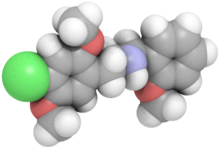25C-NBOMe
 |
|
 |
|
| Legal status | |
|---|---|
| Legal status |
|
| Identifiers | |
|
|
| CAS Number | |
| PubChem CID | |
| ChemSpider | |
| Chemical and physical data | |
| Formula | C18H22ClNO3 |
| Molar mass | 335.83 g·mol−1 |
| 3D model (Jmol) | |
|
|
|
|
|
|
|
25C-NBOMe (NBOMe-2C-C, 2C-C-NBOMe, Cimbi-82) is a psychedelic drug and derivative of the psychedelic phenethylamine 2C-C. 25C-NBOMe appeared on online vendor sites in 2010 but was not reported in the literature until 2011. It acts as a potent partial agonist for the 5HT2A receptor, and has been studied in its 11C radiolabelled form as a potential ligand for mapping the distribution of 5-HT2A receptors in the brain, using positron emission tomography (PET).
25C-NBOMe is derived from the psychedelic phenethylamine 2C-C by substitution on the amine with a 2-methoxybenzyl group. 25C-NBOMe is a clumpy white powder with a notably bitter and metallic taste. 25C-NBOMe has been found on blotter mimics sold as LSD.
Anecdotal reports from human users suggest 25C-NBOMe to be an active hallucinogen at a dose of as little as 200-500 µg insufflated and 300-600 µg buccaly (with threshold doses even lower), making it only half to a third the potency of LSD. NBOMe-substituted compounds have a diminished absorption rate passing through mucus membranes, but generally remain inactive when taken orally. Buccal, sublingual or insufflated routes of administration are all viable options. Absorption rate buccally and sublingually can be increased when complexed with HPBCD complexing sugar, however the most efficient is nasal administration, which shortens the duration while increasing intensity, but has been attributed to several overdoses due to improper dosing.
...
Wikipedia
